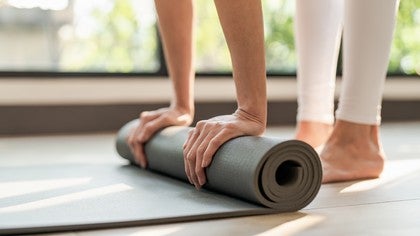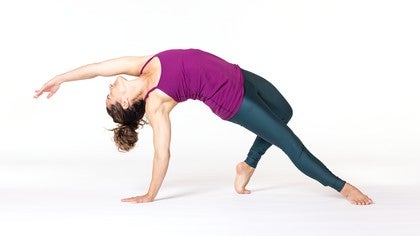
What Are the Different Types of Yoga and Which Is Best for You?
Hatha, Vinyasa, Kundalini... each style of yoga has its own particular benefits. Some are drawn to yoga to increase their strength, balance, and flexibility, help with pain relief, or healing from an injury. Others are looking to relieve anxiety and stress.
To find your perfect yoga class, a good starting place is to think about what is drawing you to yoga right now. Are you craving a soulful, sweaty workout? A calming, soothing practice? Or something in between?
What follows are descriptions of some of the most common types of yoga practiced in North America today. Read on to discover which ones are right for you.
Hatha
Hatha Yoga has become a generic term for yoga practiced in the American mainstream. Expect a well-rounded, flowing practice that includes sun salutations, core work, some backbends or inversions, and a final restorative pose or short meditation. Hatha yoga classes are easily adapted to all levels of fitness and yoga proficiency.
Vinyasa
Emphasizing strength, flexibility and coordination, Vinyasa Yoga classes are often referred to as “flow yoga” because of the repetition of sun salutations, a more vigorous sequence of asanas, or poses, that flow from one to the next. Vinyasa practices are linked to breath, with each movement typically accompanied by an inhale or exhale.
Ashtanga
Similar in vibe and intensity to Vinyasa Yoga, Ashtanga yoga is a more structured style. Popularized by Sri K. Patthabi Jois in Pune, India, Ashtanga Yoga arrived in the United States in the 1990s, where it became popular with celebrities (most notably, Madonna). Ashtanga consists of six sequences of increasing difficulty. It’s a lifelong practice, with adherents working independently or under the tutelage of instructors as they advance through the six cycles. Sessions are typically longer than a traditional yoga class, with students working at their own pace.
Restorative and Yin Yoga
Restorative and Yin practices employ long, slow holds with supportive props to promote healing and prepare the mind for meditation. This type of yoga is especially beneficial for people experiencing trauma, stress, anxiety, or grief. If you struggle with traditional, seated meditation, these introspective practices may offer a more physical path to quieting the mind.
Kundalini
Recently gaining in popularity, Kundalini Yoga is a distinct style of yoga that taps into our creative potential through practices including dynamic movements (kriyas), breathing techniques, chanting mantras, and meditation. These practices are thought to awaken the dormant energy at the base of the spine and draw it upward through each of the seven chakras. The result is a deeper connection with our infinite potential.
Iyengar
Popularized by Indian yogi B.K.S. Iyengar, this form of yoga uses props such as folding chairs, yoga blocks, straps, and blankets to wring the benefits from each pose. The attention to precise details and anatomical alignment make this a very safe, inclusive, and healing practice, suitable for all levels of fitness.
Chair Yoga
As the name suggests, this form of yoga is performed while seated on a chair or using a chair as a prop for balance. While not necessarily a beginner practice, chair yoga is adaptable for special needs such as injuries and is a mainstay for seniors. Expect to see many of the same postures that you would in a traditional yoga class, as well as an attention to breath and mindfulness.
Acro Yoga
Attempt feats of strength and daring with this fun, partner-based practice that builds trust and connection between participants. This form of yoga develops strength, focus, and balance while feeling like play. Even better? The whole family can play!
Yoga Nidra
Yoga Nidra, or yogic sleep, invites us to wake up to who we truly are through breathing, meditation, and visualization practices. Be sure to have plenty of props on hand: blocks, blankets, pillows/bolsters, and a strap. The effects of this incredibly restful and restorative practice have been compared to a “power nap.”
Subtle Realm
This phrase refers to a variety of meditation techniques designed to increase receptivity to and capacity for the intangible and mysterious.
Bhakti
This practice is about cultivating unconditional love. Bhakti Yoga has a devotional flavor designed to expand generosity of heart through techniques including chanting (also known as kirtan) and mantra.
Tantra
Despite its racy reputation as a shortcut to hotter sex, tantra is actually a set of practices and rituals to enhance spiritual growth and physical well-being in all areas of life. For example, using meditation to bring awareness to our inner landscape and gather prana (life-giving force) to promote a natural flow of energy.
Freedom Style
American yoga teacher Erich Schiffmann developed this deeply personal practice. Instead of a prescribed flow, students explore the spaces between and within the asanas and other practices in a creative, intuitive way. Give yourself the freedom to be your own teacher.
There’s a world of yoga out there to explore. If at first you don’t find the experience you’re looking for, try another style, teacher, or format. You might be surprised at what ends up being the most rewarding for body, mind, and spirit.
Comments

You need to be a subscriber to post a comment.
Please Log In or Create an Account to start your free trial.













